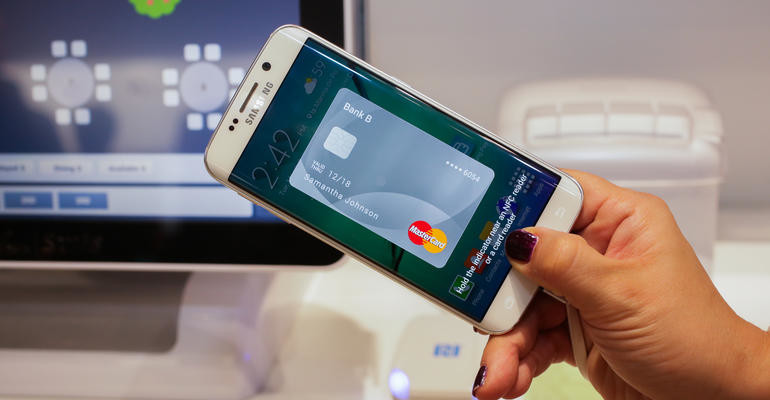Samsung announced they were coming out with Samsung Pay on March 1st 2015 (Samsung, 2015), just two months before Google announced they were coming out with Android Pay in May 2015. This announcement came quickly after Samsung’s acquisition of LoopPay Inc. a developer of the magnetic-stripe radio-field technology (Woodward, 2015). While adoption of mobile payments has been slow, Samsung believes that their new technology will help to increase the use of mobile payments.
History
Samsung’s relationship with LoopPay began when Samsung’s Global Innovation Center invested in LoopPay allowing LoopPay to fund their MST technology development (Kovach, 2015). Samsung then acquired LoopPay Inc. in February 2015. This new relationship with LoopPay allows Samsung to expand their efforts into the mobile payment spectrum, working towards their goal of building secure, user-friendly, and smart mobile payments.
Getting ready for Samsung Pay
Due to the fact that LoopPay utilizes a magnetic-stripe, radio-field technology rather than nearfield communication (NFC) (like Apple Pay and Andriod Pay) adoption of this technology should be fairly simple. In fact, supposedly Samsung Pay currently has an advantage over Apple Pay and Andriod Pay, because there are approximately 8 million POS terminals in the United States (Woodward, Samsung Pay’s Mag-Stripe Emulation Advantage Might Be Short-Lived, 2015) and 30 million merchant locations worldwide (Samsung, 2015) that work with magnetic stripe. Samsung Pay will work with all of these devices.
However, with EMV technology coming out, terminals are being upgraded with EMV and NFC capabilities. With the EMV terminals, the terminal will default to an EMV transaction if the credit or debit card has an EMV capability. Therefore, a customer is limited to uploading a credit card or debit card that has an EMV chip to Samsung Pay. With more credit and debit cards being distributed by issuers with the EMV chip and more merchants upgrading to EMV terminals, Samsung Pay will have to find ways to be compatible with this technology.
Payment Processors Involved
Samsung Pay already has relationships with JPMorgan Chase & Co (Chase Paymetech), First Data Corp., Total System Services Inc. (TSYS), and Bank of America Corp, InJong Rhee, the EVP of Samsung Electronics, believes the number of relationships will grow (Woodward, Samsung Pay Set U.S. Debut for Sept. 28, With a One-month Trial Startuing Aug. 25, 2015).
Issuers and Networks Involved
In addition to payment processers, Samsung is working with issuers: Synchrony Financial, JPMorgan Chase & Co, Bank of America Corp and networks: MaterCard Inc., Discover Financial Services, American Express Co., and Visa Inc (Woodward, Samsung Pay Set U.S. Debut for Sept. 28, With a One-onth Trial Startuing Aug. 25, 2015).
Specifically Samsung is partnering with Visa to use the Visa Digital Enablement Program (VDEP) and the Visa Token Service (VTS) (Jesdanun, 2015).
How it Works/Security
When you are ready to pay you will swipe your finger up from the bottom of the mobile device to see a list of your cards. The most recently used card will be the default card option, but you will swipe your finger right and left to choose the card you want to utilize for payment. You will then hold the phone near the stores terminal and place your finger over the home button to authorize the transaction with your fingerprint.
Samsung pay will utilize various security features including:
- Fingerprint scanner-Samsung Pay will have fingerprint authorization with their new phones linked to Samsung Pay (Samsung, 2015).
- Tokenization-Samsung with replace sensitive card data with a one-time-use security code
- Magnetic Strip tech (MST)- this technology creates various changing magnetic fields by putting alternating currents through an inductive loop. This is then received by the magnetic read head of the credit card reader. The field only exists during a transmission after which is rapidly deleted (Sacco, 2015).
- Samsung KNOX and ARM TrustZone- are Samsung’s mobile security platforms that will work to help protect against fraudsters and data attacks. In addition Samsung’s Find My Mobile featue allows people to wipe their devices remotely to further ensure Samsung Pay data is not compromised if a phone is lost (Samsung, 2015).
When it Will Arrive
Samsung Pay was released in South Korea on August 20th, 2015 and is set for testing phase in the U.S. starting on August 25th, 2015 with a launch date on September 28th, 2015 (Jesdanun, 2015).
